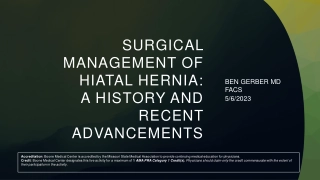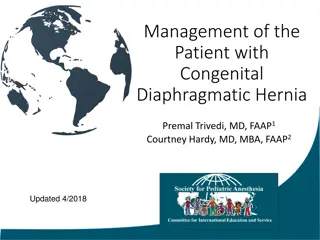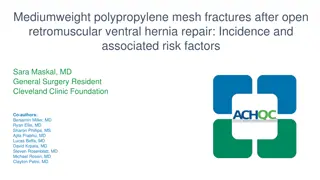Comparative Outcomes of Open Versus Robotic Ventral Hernia Repair
This study compares the outcomes of open versus robotic retro-muscular ventral hernia repair, focusing on minimally invasive approaches and their impact on clinical results. Preliminary findings reveal differences in surgical site infections, length of hospital stays, and other complications between the two techniques. The research emphasizes the potential benefits of minimally invasive approaches in abdominal wall reconstructions for improved patient outcomes.
Download Presentation

Please find below an Image/Link to download the presentation.
The content on the website is provided AS IS for your information and personal use only. It may not be sold, licensed, or shared on other websites without obtaining consent from the author.If you encounter any issues during the download, it is possible that the publisher has removed the file from their server.
You are allowed to download the files provided on this website for personal or commercial use, subject to the condition that they are used lawfully. All files are the property of their respective owners.
The content on the website is provided AS IS for your information and personal use only. It may not be sold, licensed, or shared on other websites without obtaining consent from the author.
E N D
Presentation Transcript
Open versus Robotic REtrOmuscular Ventral Hernia Repair: Preliminary outcomes of ORREO trial Jeremy Warren, MD FACS University of South Carolina School of Medicine Greenville Prisma Health Upstate
Disclosure Intuitive (JAW, AMC) Study funded with SAGES grant
Background Does minimally invasive abdominal wall reconstruction improve clinical outcomes?
Background 222 open vs 111 roboticRM 4 vs 2% SSI (p=0.05) LOS 3 vs 2 days (p<0.001) Carbonell AM, Ann Surg 2018
Background 237 rTAR vs 594 oTAR from 6 studies No difference in SSI (3.6 vs 5.2%; p=0.44) Lower SSO for rTAR (5.3 vs 11.5%; p=0.02). No diff in SSOPI Lower systemic complications rTAR (6.3 vs 26.5%; p<0.001) Shorter LOS with rTAR Bracale U, Hernia 2021
Background 350 robotic matched to 759 open; all patients >65y/o LOS: 1 vs 4 days (p<0.001) No difference in complications Slight improvement in QOL at 1 year Collins CE, Ann Surg 2021
Methods Prospective RCT Inclusion: Hernia 7-15cm At least one: DM, COPD, BMI >30, current smoker Exclusion: Presence of stoma Wound class 3 or 4
Methods Primary endpoint: Composite outcome SSO (excluding simple seroma) SSOPI SSI Readmission Recurrence
Methods Power analysis: Based on retrospective review of open / robotic cases Composite outcome: Open - 52.2%, Robotic - 24.1% Calculated 46pts in each arm to detect difference Enrolled 100 total (50 each arm) Intention to treat analysis: 5 patients converted to open included in robotic arm
Results R No difference in primary outcome Shorter LOS SSIPI - wound opening, perc drain x2 (open); wound opening (robotic) All SSOPI were perc drains
Results 5 patients required conversion to open 0 SSI 3 SSO (2 seroma, 1 cellulitis) 0 SSOPI
Pending results R PROs Recurrence at 2 years
Limitations Small sample size Recruitment and randomization Follow-up Evolution of technique (eTEP, fixation), ERAS (TAP blocks)
Summary First RCT comparing open v robotic VHR. Robotic repair appears to shorten LOS compared to open, as seen with other studies. Future study with larger sample size needed to determine other differences.




![❤[READ]❤ Robotic Exploration of the Solar System: Part I: The Golden Age 1957-19](/thumb/21623/read-robotic-exploration-of-the-solar-system-part-i-the-golden-age-1957-19.jpg)


















